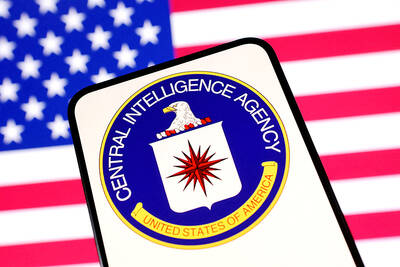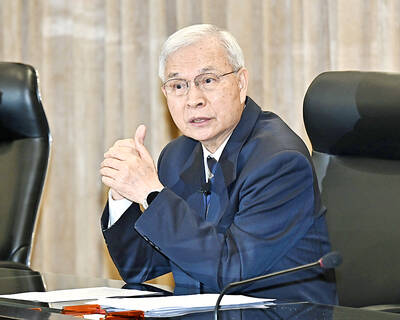The US signed over two decommissioned Oliver Hazard Perry-class frigates to Taiwan last week, which are scheduled to enter the navy’s service by the end of May.
The vessels were signed over on Thursday at a ceremony in Charleston, South Carolina, attended by Commander of the Navy Admiral Huang Shu-kuang (黃曙光), Representative to the US Stanley Kao (高碩泰) and unnamed US officials.
The event was a deliberately low-key affair, purportedly in a bid to avoid provoking diplomatic conflict, particularly with China.
The Ministry of National Defense refused to comment on the transfer, but Democratic Progressive Party Legislator Tsai Shih-ying (蔡適應) yesterday confirmed the handover.
The navy dispatched a team of officers to the US to receive training in how to operate the frigates and the vessels would be sailed to Taiwan either jointly or separately, depending on the progress of the training, with both vessels expected to arrive within two months, Tsai said.
“The two frigates have been retrofitted to extend their service lives by about 30 years, making them a highly cost-effective option for the navy,” Tsai said.
The USS Taylor and the USS Gary were in service between 1984 and 2015. They were purchased for a total of about NT$5.5 billion (US$177.21 million) making them substantially cheaper than Taiwan-made Cheng Kung-class frigates — the design of which is based on Perry-class frigates — which cost up to NT$17 billion each.
The US Navy began to deploy Perry-class guided missile frigates in the 1970s and 1980s. The US built 51 of the frigates for its navy and authorized its allies to build them. Eight such frigates have been built in Taiwan.
Despite calls to rename the two vessels after naval heroes, the two frigates have been named the Mingchuan after Qing Dynasty Taiwan governor Liu Ming-chuan (劉銘傳) and the Fengjia after poet Chiu Feng-jia (丘逢甲), who led the resistance against Japan following the Qing Dynasty’s cession of Taiwan to Japan.
In related news, Huang is scheduled to have meetings with high-level US officials, likely from the White House and the Pentagon, although details of the meetings were not revealed, Tsai said.
Huang is the first high-level Taiwanese military official to visit the US following the passage of the US National Defense Authorization Act for Fiscal Year 2017, which for the first time included a section on senior military exchanges with Taiwan.
“Huang is not the first and will not be the last high-level official visiting the US…. I believe there will be military exchanges involving higher-level officials in the near future,” including the minister of national defense and the chief of general staff, reflecting closer defense ties between the two nations, Tsai said.

The CIA has a message for Chinese government officials worried about their place in Chinese President Xi Jinping’s (習近平) government: Come work with us. The agency released two Mandarin-language videos on social media on Thursday inviting disgruntled officials to contact the CIA. The recruitment videos posted on YouTube and X racked up more than 5 million views combined in their first day. The outreach comes as CIA Director John Ratcliffe has vowed to boost the agency’s use of intelligence from human sources and its focus on China, which has recently targeted US officials with its own espionage operations. The videos are “aimed at

STEADFAST FRIEND: The bills encourage increased Taiwan-US engagement and address China’s distortion of UN Resolution 2758 to isolate Taiwan internationally The Presidential Office yesterday thanked the US House of Representatives for unanimously passing two Taiwan-related bills highlighting its solid support for Taiwan’s democracy and global participation, and for deepening bilateral relations. One of the bills, the Taiwan Assurance Implementation Act, requires the US Department of State to periodically review its guidelines for engagement with Taiwan, and report to the US Congress on the guidelines and plans to lift self-imposed limitations on US-Taiwan engagement. The other bill is the Taiwan International Solidarity Act, which clarifies that UN Resolution 2758 does not address the issue of the representation of Taiwan or its people in

US Indo-Pacific Commander Admiral Samuel Paparo on Friday expressed concern over the rate at which China is diversifying its military exercises, the Financial Times (FT) reported on Saturday. “The rates of change on the depth and breadth of their exercises is the one non-linear effect that I’ve seen in the last year that wakes me up at night or keeps me up at night,” Paparo was quoted by FT as saying while attending the annual Sedona Forum at the McCain Institute in Arizona. Paparo also expressed concern over the speed with which China was expanding its military. While the US

SHIFT: Taiwan’s better-than-expected first-quarter GDP and signs of weakness in the US have driven global capital back to emerging markets, the central bank head said The central bank yesterday blamed market speculation for the steep rise in the local currency, and urged exporters and financial institutions to stay calm and stop panic sell-offs to avoid hurting their own profitability. The nation’s top monetary policymaker said that it would step in, if necessary, to maintain order and stability in the foreign exchange market. The remarks came as the NT dollar yesterday closed up NT$0.919 to NT$30.145 against the US dollar in Taipei trading, after rising as high as NT$29.59 in intraday trading. The local currency has surged 5.85 percent against the greenback over the past two sessions, central